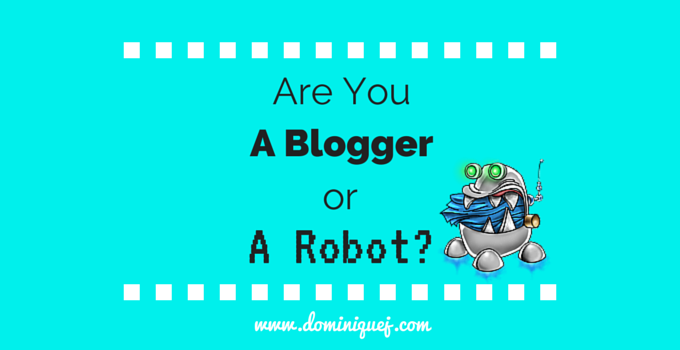There’s nothing worse than dull, robotic, emotionless writing that looks like it was written by an 80 year old English professor who refuses to use contractions. Unfortunately, that’s the way a lot of bloggers end up writing because they think it makes them seem more professional and articulate. I’ve written hundreds of blog posts, and studied some of the most successful bloggers, and I can guarantee you that that trying to sound “professional” usually isn’t the best approach. Leave the robotic writing back in your high school English class where it belongs. You’re a blogger, not a robot.
Not sure how to make the transition? Here are some tips to make your blog more personable, and less robotic.
1. Write How You Talk
I’ve written about this before, but it can’t be said enough: write the way you talk. Writing in a conversational tone is one of the best ways to connect with your readers. It makes the person reading your article feel like you’re talking directly to them, even though hundreds or thousands of people will actually be reading it.
When you start talking in general terms (i.e. one should blog in such a way that….) it’s so impersonal and unengaging that it’s not memorable and doesn’t connect with the reader.
That’s why motivational and inspriational speakers always talk directly to their audience using words like “you”, “us”, and “we”. It creates a more intimate moment than talking in the third person. Here’s a great example. Check out this Ted Talk from one of the most inspirational speakers/coaches/writers/machines? alive, Tony Robbins. Pay attention to how he’s talking TO the audience, and not at them.
Now imagine that if instead of using words like “you”, and “we”, he used more general words like “people” or “them”. It completely changes everything right? That powerful speech wouldn’t have anywhere near the same effect. The same thing goes for your writing.
2. Don’t Pretty It Up
Sure, on Instagram everyone is rich and balling out of control. But that’s not real life. If your blog makes it seem like you’re perfect, you become unrelatable. You don’t have to talk about your hemorrhoids or anything, but don’t put yourself above your audience. For instance, I make it no secret that I suck at graphic design. I’ve said it before, and I’ll say it until the day I feel like I’m halfway decent.
But instead of just trying mask the fact that I’m not a graphic designer, I wrote a post about how it’s one of my weaknesses, and gave solutions on how I deal with it because I know that someone else is struggling with the exact same thing. The key is to acknowledge your struggles, but then give some actionable steps or tools that you’ve used to help fix it. If I would’ve just wrote a blog post about how crappy I am with Photoshop, nobody would want to read that. But by turning it into a post about easy to use tools for people that aren’t great at design, it becomes a much more useful post.
Basically, don’t turn your blog into a pity party, but don’t be afraid to be honest without caking on 5 pounds of makeup to pretty it up.
3. Put a name/face to each blog post
This tip is primarily for companies or blogs with multiple writers, but it’s something that every blog should do. Don’t be the nameless, faceless corporation. Let people know who’s writing the content they’re reading. Whether it’s with a byline at the end of the post, or with your name in the “By ____” section at the beginning of the article, acknowledge that a real person wrote the post.
I’m going to use one of my favorite companies that does content marketing right, as an example.. Trulia! On their blog, they let it be known who writes each post.
It might not seem like a huge deal, but trust me, it is. Letting people see who wrote each post makes the content more human and personable. And if you’re giving out any type of advice on your site, then it’s even more important to put your name on it. Instead of having all of your blog posts being written by “Admin”, have them written by “Joe” (or whatever your name is).
4. Use Real Life Examples
One of the things I like to do a lot on this blog is draw from my personal experiences. So throughout different blog posts, I’ll give examples based on situations I’ve experienced that relate to the article you’re reading. Any time you can tell a story that helps relay your overall message, you should absolutely do it. Don’t just take my word for it. The kings of content marketing, Hubspot, wrote about the power of story telling, and so did CoSchedule.
Here’s why using real life examples and story telling is so effective for bloggers. Like John Lee Dumas always says, we learn from stories. Back in the days before movies or crappy reality TV shows, stories were how people got their messages across. Whether you’re talking about cautionary tales about poor Conrad getting his thumbs cut off, or autobiographies filled with life lessons, stories can convey messages better than just stats or advice. Giving those real life examples makes your blog easier to relate to, and captures readers because a good story is like a tube of Pringles, once you start, you just can’t stop until you get to the end.
[Tweet “A good story is like eating Pringles. Once you start, you can’t stop until you finish!”]
5. Invite Readers To Connect With You
Whether it’s asking them to tweet you or to leave a blog comment, always make it known that you’re open to talking with your readers and connecting with them. This is something that a lot of blogs don’t do, but they should. They might ask you to follow them on Twitter, but rarely ever ask you to tweet them with your thoughts on their content. But you’re not going to be like them!
The great thing about this tip is that it’s really easy to put into action. I mean like right now. It’s as simple as ending each blog post with “have any thoughts on whatever your blog topic is? Leave a comment below or tweet me!”, Boom! Brief and right to the point. It’s just a call to action to get people to do something after reading your post instead of just closing out the tab, and it lets them know that you’re open to conversation because you’re a blogger, not a robot.
Let’s Stop The Robots!
Ready to go from a faceless, boring, and generic robot to a dynamic, interesting and personable blogger? Start putting these tips into action TODAY. It might take some time to get used to writing in a more personal/conversational style, but I know you can handle it.
Have any tips or questions on how to make your blog less robotic and more human? Let me know in the comments below, or tweet me! (see what I did there?)




